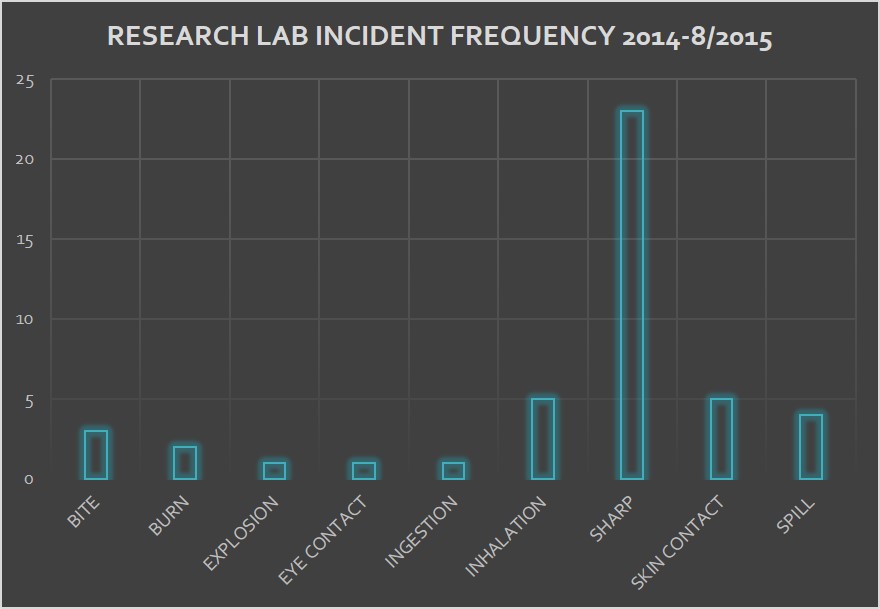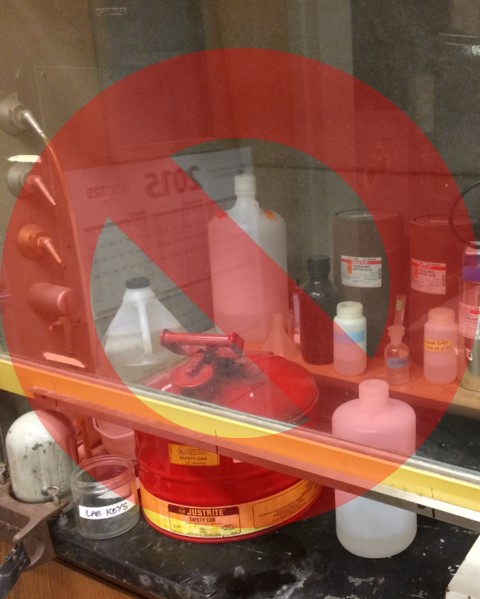2016 Commitment to Laboratory Safety and Five Focus Areas
WSU is committed to the safety of our researchers, instructors and students and to the continuity of research and education. In a memorandum released on January 19, 2016 the Co-Provosts, Vice President for Research and Vice President for Finance and Administration requested the support and commitment to laboratory safety of the Deans, Associate Deans and those responsible for laboratories within each college.
Additionally, two other statements released by The Office of the President on February 10, 2016 reaffirmed the President’s and WSU’s commitment to strengthening University safety. The memorandum and president’s statements are provided under the Resources menu to the right.
The Office of Environmental Health and Safety (EH&S) and the Office of Research Assurances (ORA) reviewed laboratory incidents and cleanup responses in 2014 and 2015 (see graphs below). Five (5) safety focus areas (listed below) were identified that could contribute significantly to improving laboratory safety.
Research Lab Incident Frequency in 2014 and 2015


Five Laboratory Safety Focus Areas for 2016
- Store chemical waste in appropriate, properly labeled containers.

Increasingly, chemical wastes that generate gasses have contributed to waste container explosions (e.g. Nital – Nitric Acid and Alcohol etchants). Please store wastes generating gasses in containers with vented lids. It may be necessary to leave the lid partially or fully removed until the material is no longer generating gas, with the container placed in secondary containment. EH&S will work with you to provide appropriate containers.
All waste containers must be labeled with the full, written chemical name (no abbreviations), the percent waste chemical composition(s) and primary hazard (e.g. corrosive or flammable), and have the words “Dangerous Waste”. EH&S will provide free adhesive labels for your containers. - Evaluate procedures for handling glassware, needles, scalpels, microtomes, and other sharp objects.
Cuts or punctures from broken glassware, needles, scalpels, microtomes and other sharp objects are the most common research laboratory injury. Please identify potential sharps hazards and provide cut and puncture resistant gloves or contact EH&S or ORA to identify additional options to prevent injury from sharps and broken glass. - Replace mercury containing devices.
Mercury spills are the most frequent chemical release contaminating WSU research laboratories. Mercury spill cleanups interrupt research. Mercury spill cleanup and waste disposal is expensive. While some research may require the use of mercury, we encourage substituting other types of equipment and materials whenever possible. Please contact EH&S to exchange mercury thermometers for alcohol thermometers and to explore the replacement of mercury manometers. - Remove unnecessary equipment and containers from fume hoods to minimize negative impacts on air flow.

Storing unnecessary equipment and containers in fume hoods affects the air flow, potentially resulting in employee exposure to hazardous air contaminants. Please limit the equipment and chemicals in fume hoods to those necessary to support work. Remove and appropriately store equipment or chemicals not actively involved in work. Please do not store materials in fume hoods within six (6) inches of the sash opening. Please close the sash when not actively manipulating materials within the hood. - Maintain access to emergency equipment (e.g. eyewashes, emergency showers, fire sprinklers, fire extinguishers).
Please do not store materials where they prevent access or proper function of emergency equipment. Eighteen (18) inches clearance is required below fire sprinkers (minimum). Please contact EH&S for assistance evaluating the need for new/additional emergency wash facilities.
EH&S, ORA and Safety Committees
EH&S, ORA, and safety committee membership will evaluate improvement in the focus areas while performing regular work in research, teaching, and clinical laboratories.
Please visit the Laboratory Safety, Laboratory Safety Manual, Office of Research Assurances, Biosafety, and Radiation Safety websites for addtional laboratory safety information.
Please contact EH&S (335-3041), ORA (335-7183), Biosafety Office (335-7195), Radiation Safety Office (335-8916) or your safety committee for more information on the five focus areas and WSU’s safety commitment.
Resources:
- 2016 Safety Committees and Safety Commitment for Laboratories Memorandum
- Guide to Implementing a Safety Culture in Our Universities (APLU)
- Presentation to Council of Research (CoR): Implementing Safety Culture in Our Universities (APLU)
- Toolbox for Implementing a Safety Culture (APLU)
- Advancing Safety Culture in the University Laboratory (Stanford Task Force Report)
- President’s Statement on WSU’s Commitment to Safety
- Statement of WSU President’s Commitment to University Safety